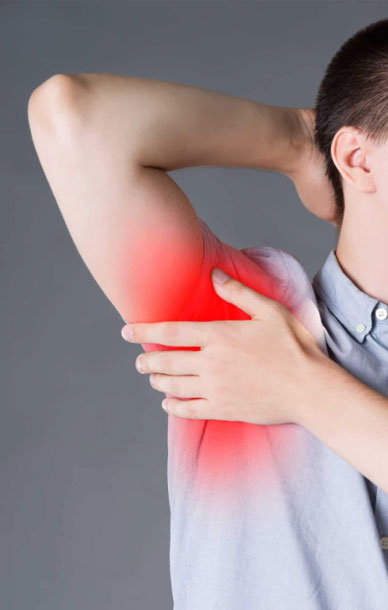Sweat is produced by glands in the deeper layer of the skin, the dermis. Sweat glands occur all over the body, but are most numerous on the forehead, the armpits, the palms and the soles of the feet. Sweat is mainly water, but it also contains some salts. Its main function is to control body temperature. As the water in the sweat evaporates, the surface of the skin cools. An additional function of sweat is to help with gripping, by slightly moistening the palms.
Normal sweating
Normal, healthy sweating is caused by:
- Hot temperatures, such as in summer
- Physical exercise
- Emotional stress
- Eating hot or spicy foods
- Fever associated with illness.
Are you considering participating in a clinical trial?
Patient participants with a disease or condition may decide to participate in clinical trials to contribute to better understanding of, or better treatment or a potential cure for their disease or condition. In some cases, clinical trials can provide access to new interventions before they are widely available.
Trials also offer the hope of developing better interventions or tests for a particular disease or condition, so that even if a trial does not provide a benefit for an individual, it may provide benefits for others with the disease in the future.
As a patient participant, even when you receive the highest quality care, you may also benefit from additional support and attention provided by clinical trial staff who understand your disease or condition (source: australianclinicaltrials.gov.au)
If you would like to take part in a HS trial, click here!

Increased sweating (hyperhidrosis)
Abnormal increased sweating is known as hyperhidrosis. Idiopathic hyperhidrosis is the most common form of excessive sweating. It is called idiopathic because no cause can be found for it. It can develop during childhood or later in life and can affect any part of the body, but the palms and soles or the armpits are the most commonly affected areas. The excessive sweating may occur even during cool weather, but it is worse during warm weather and when a person is under emotional stress.
Some known causes include:
- Obesity
- Hormonal changes associated with menopause (hot flushes)
- Illnesses associated with fever, such as infection or malaria
- An overactive thyroid gland (hyperthyroidism)
- Diabetes
- Certain medications.
In the majority of cases, no investigations are required to diagnose hyperhidrosis. Occasionally, a blood test for thyroid disease is recommended.
Treatment for excessive sweating
Treatment for excessive sweating depends on the cause. This may include:
- Reducing weight – if obese
- Medical management – to reduce the hot flushes of menopause
- Antiperspirant applications – sprays, powders and roll-ons
- Iontophoresis – the activity of sweat glands is temporarily reduced by passing a low-level electric current through the skin
- Botox injections – to paralyse sweat glands. The effect from a single injection lasts six to nine months
- Surgery – to the nerves that control sweat glands may be considered in severe cases where all other treatments have been unsuccessful.
Self-help strategies for hyperhidrosis
Some strategies for managing hyperhidrosis at home include:
- Wear loose clothing.
- Use antiperspirants that contain aluminium chloride and are designed for hyperhidrosis – follow the instructions carefully. While advertised mainly for use in the armpits, these agents can also be used on the palms, soles and forehead or wherever the hyperhidrosis occurs.
Reduced sweating (hypohidrosis)
Reduced sweating is called hypohidrosis, if there is partial loss of sweating, or anhidrosis if there is complete lack of sweating. This can occur for a number of reasons, which include:
- Some skin disorders
- Burns to skin that damage the sweat glands
- Underactive thyroid (hypothyroidism)
- Dehydration
- Prolonged excessive heat or exercise during hot weather.
Lack of sweating may create problems of temperature control and lead to steep rises in body temperature during hot weather. Occasionally, this can be life threatening.
Heat stroke and heat exhaustion
Heat stroke (or sun stroke) can occur in hot weather when not enough sweat is produced to keep the body cool. Symptoms can include:
- Muscle cramps
- Headache
- Nausea
Excessive loss of body salts and water can lead to a life-threatening complication known as heat exhaustion. Heat stroke can be managed, and heat exhaustion prevented, by seeking a cool, shaded place, drinking plenty of fluids and sponging the body with water, if necessary.
Things to remember
- Sweat keeps the body cool as it evaporates from the skin.
- Heat stroke occurs when sweat can’t evaporate fast enough to cool the body.
- Hyperhidrosis is excessive sweating.
Known causes of heavy sweating include obesity, thyroid disease and diabetes.
To book a consultation please call us on 9654 2426 or email appointments@sinclairdermatology.com.au
Why Choose Sinclair Dermatology?
 Leader in skin and hair loss treatment and research
Leader in skin and hair loss treatment and research More than 50% of dermatology research papers in Australia are published by our team
More than 50% of dermatology research papers in Australia are published by our team Largest dermatology clinical trial research centre in Australia
Largest dermatology clinical trial research centre in Australia Only medical centre in Australia to use 3D whole body imaging technology to map moles and lesions for skin cancer detection.
Only medical centre in Australia to use 3D whole body imaging technology to map moles and lesions for skin cancer detection. Onsite pathology and compounding pharmacy
Onsite pathology and compounding pharmacy Our dermal clinic uses state of the art laser machines
Our dermal clinic uses state of the art laser machines




